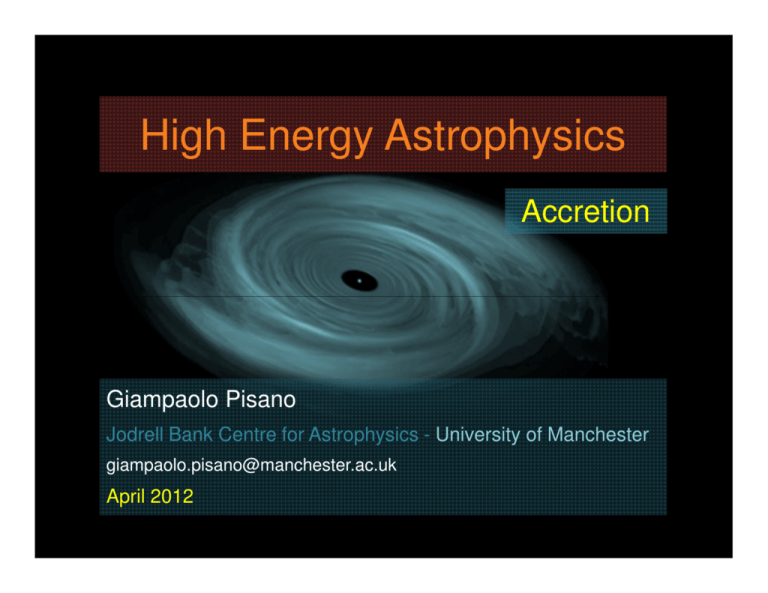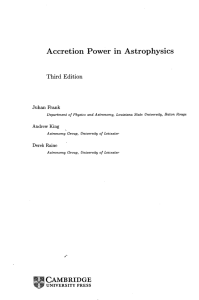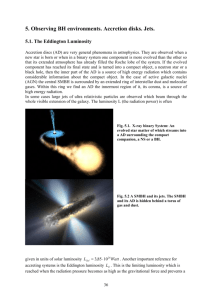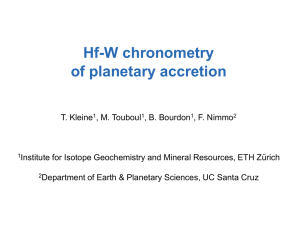High Energy Astrophysics - Jodrell Bank Centre for Astrophysics
advertisement

High Energy Astrophysics
Accretion
Giampaolo Pisano
Jodrell Bank Centre for Astrophysics - University of Manchester
giampaolo.pisano@manchester.ac.uk
April 2012
Accretion
- Accretion efficiency
- Eddington Luminosity
- Applications of the Eddington limit
- Accretion discs
References:
- Frank, King & Raine, Accretion Power in Astrophysics - Chap.1
- Longair, High Energy Astrophysics - Vol 2 - Par. 16.2
- Melia, HEA - Chap.6
Accretion Efficiency 1/3
- Introduction
- XXth century: gravity considered inadequate to explain the Sun power
Nuclear reactions
- XXIth: nuclear power inadequate to explain powerful objects in the Universe
Gravitational energy from accretion in binary systems
Accretion onto compact objects is a powerful mechanism
for producing high energy radiation
Accretion Efficiency 2/3
- Consider a mass M and a falling body with mass m acquiring kinetic energy
from the gravitational potential:
1
Mm
mv 2 = G
2
r
- At the surface of M, i.e. r=R , all the kinetic energy is converted in heat:
∆Eacc =
GMm
- Gravitational potential energy released
R
- If all the energy is converted into
dE
Mm&
L
=
=
G
radiation the luminosity is :
dt
R
dm
dt
- Mass accretion rate
with
2GM
rS c 2
- Using the Schwarzschild radius: rS = 2 → GM =
c
2
Lacc = ξ m& c 2 - Accretion Luminosity
with: ξ =
m& =
rS c 2 m&
→L=
2 R
1 rS
- Accretion efficiency
2R
Accretion Efficiency 3/3: Examples
- Using:
M
km
rS ≅ 3
M
Θ
→ξ=
1 rS
2R
1
3
M
ξ =
2 R (km) M Θ
White Dwarf
R ~ 5000 km
M ~ 1 .4 M Θ
→ξ=
3 × 1 .4
2 × 5000
ξ = 4.2 ×10 −4
→ξ=
3 × 1. 4
2 × 10
ξ = 0.21
Neutron Star
R ~ 10 km
M ~ 1 .4 M Θ
Black Hole
rS
→
ξ
=
{ R = 3rS (last stable orbit)
2 × 3rS
Nuclear fusion
ξ = 0.17
- In the p-p chain the efficiency is:
Note: it would be larger
for a rotating BH
ξ=
∆Enuc
= 0.007
2
mc
Spherical Accretion: Examples
White Dwarfs & Neutron Stars
- Isolated WD and n-stars within the Interstellar Medium (ISM):
Spherical accretion of matter
( X-ray telescopes now capable to resolve the ‘capture’ region’ )
Black Holes
- Supermassime black-holes in galactic nuclei
- Can capture matter at 1 l.y. or more depending on their mass
- Impact of angular momentum on gas dynamics not important at
those distances:
Spherical accretion of matter from ISM
Eddington Luminosity 1/4
- Limits on accretion
- Luminosity due to accretion is: Lacc = ξ m& c 2
&
Accretion depends on the mass accretion rate m
- There is anyway a limit on the accretion rate:
Luminosity emitted in form of photons
Interaction with the infalling matter
Radiation pressure in direction opposite to gravity
Equilibrium between Gravitational and Radiation Pressure Forces
Eddington Luminosity 2/4
- Eddington luminosity derivation
Assumptions
- Steady spherically symmetrical accretion
- Accreting material to be mainly hydrogen and to be fully ionised
- The radiation exerts a force mainly on the free electrons through:
Thomson scattering
The electrons drag the protons with them by Coulomb force
- The total gravitational force is given by:
Fgrav =
GM
(m p + me )
2
r
Fgrav ≈
GM
mp
2
r
Eddington Luminosity 3/4
- The radiation force equals the rate at which the electron absorbs
the photons momentum:
Frad
Nγ
∆t
=
Nγ
∆p
L
σ
hν
=
× T2×
=
× p1γ =
∆t
hν 4π r
c
∆t
L
×f
hν
Total number of scattered photons
f =
p1γ =
f : fraction of photons scattered at distance r
(Spherical homogeneous emission)
Lσ T
4π cr 2
hν
c
p1γ : single photon momentum
σT
4π r 2
σ T : electron Thomson cross - section
Frad =
Eddington Luminosity 4/4
- In the limit case when the gravitational force is balanced by the
radiation pressure force:
Fgrav = Frad →
GMm p
r2
=
Lσ T
4π cr 2
- Solving:
LEdd =
4π GMm p c
σT
M
W - Eddington Luminosity
≅ 1.3 × 1031
MΘ
- Maximum luminosity due to accretion
- At greater luminosities: Frad > Fgrav Accretion halted
- Valid under assumptions above
Accretion
- Accretion efficiency
- Eddington Luminosity
- Applications of the Eddington limit
- Accretion discs
References:
- Frank, King & Raine, Accretion Power in Astrophysics - Chap.1
- Longair, High Energy Astrophysics - Vol. 2 - Par. 16.2, 16.3
Applications of the Eddington Limit 1/7
Accretion rates
- The maximum luminosity due to accretion is the Eddington luminosity
- But not all the objects are equally compact different efficiencies
LEdd ≥ Lacc = ξ m& c 2
We can set an upper limit on the Mass accretion rate
Example
M = 1M Θ
ξ ≈ 0.2
→ LEdd ≈ 1031 W
LEdd
1031
14
−1
22
−1
→ m& ≤
=
≅
5
×
10
kg
s
=
2
×
10
kg
yr
ξ c2
0.2 × (3 × 108 ) 2
m& ≤ 10 −8 M Θ yr −1
- We don’t expect rates higher than that in a steady case
Applications of the Eddington Limit 2/7
Mass estimates
- Consider a source accreting onto a central object with accretion luminosity:
Lobs
- We can compare it with LEdd to estimate a lower limit for the mass of the
central object:
M
W
Lobs ≤ LEdd ≅ 1.3 × 1031
MΘ
M
Lobs
≥
31
M
1
.
3
×
10
Θ
The lower limit applies if the source radiates at the Eddington limit
Applications of the Eddington Limit 3/7
Temperature definitions and ranges
- Continuum spectrum of emitted radiation characterised by a temperature:
hν ≈ kTrad
Trad =
hν
k
- Radiation temperature
Temperature related to the energy of a typical photon
- Consider an accreting source with radius R and luminosity Lacc , assuming
a black-body emission:
Lacc = 4πR 2σTb4
- Solving:
Tb = 4
Lacc
4πR 2σ
- Black-body temperature
Temperature the source would have to radiate the power as a Black-body
Applications of the Eddington Limit 4/7
- If we set the gravitational energy of an accreted proton-electron pair
to be equal to the total thermal energy of the two particles:
GM
GM
3
(m p + me ) ≈
m p = 2 × kT
R
R
2
Gravitational
energy
Thermal
energy
- We can derive:
Tth =
GMm p
3kR
- Thermal temperature
Temperature that the accreted material would reach if the gravitational
energy is turned entirely in thermal energy
Applications of the Eddington Limit 5/7
Optically Thick Accretion Flow
- Radiation in thermal equilibrium with accreted material before leaking
to the observer:
Trad ≈ Tb
Optically Thin Accretion Flow
- Accretion energy converted directly into radiation without further interaction:
Trad ≈ Tth
- In general the radiation temperature is in the range:
Tb ≤ Trad ≤ Tth
- Assumption: radiating material characterised by a single temperature
Applications of the Eddington Limit 6/7
Accretion on to White Dwarf
R ~ 10000km
M ~ 1M Θ
ξ = 4 ×10 −4
- Thermal temperature:
→ Tth =
GMm p
3kR
6.67 ×10 −11 × 2 ×1030 ×1.67 ×10 −27
=
3 × 1.38 × 10 − 23 ×107
Tth ≈ 5 × 108 K
kTth ≈ 43 keV
- Blackbody temperature:
M
→ Lacc = 4 ×10 − 4 × LEdd = 4 ×10 − 4 × 1.3 ×1031 Θ W = 5 ×10 27 W
MΘ
27
L
5
×
10
acc
→ Tb = 4
=4
2
4πR σ
4π ×1014 × 5.67 ×10 −8
We expect photon energies in the range
Tb ≈ 8 × 10 4 K
kTb ≈ 7eV
7 eV ≤ hν ≤ 43 keV
( Optical, UV to X-rays )
Applications of the Eddington Limit 7/7
Accretion on to Neutron Star
R ~ 10km
M ~ 1 .4 M Θ
ξ = 0.21
- Thermal temperature:
6.67 ×10 −11 ×1.4 × 2 ×1030 ×1.67 ×10 −27
→ Tth =
=
3kR
3 ×1.38 ×10 − 23 ×10 4
GMm p
Tth ≈ 8 ×1011 K kTth ≈ 70 MeV
- Blackbody temperature:
1 .4 M Θ
W = 4 × 1030 W
→ Lacc = 0.21× LEdd = 0.21× 1.3 × 1031
MΘ
30
L
4
×
10
acc
→ Tb = 4
=4
2
4πR σ
4π ×108 × 5.67 ×10 −8
We expect photon energies in the range
Tb ≈ 2 × 10 7 K
kTb ≈ 1keV
1keV ≤ hν ≤ 70 MeV
( Medium-Hard X-rays to γ-rays )
Accretion
- Accretion efficiency
- Eddington Luminosity
- Applications of the Eddington limit
- Accretion discs
References:
- Frank, King & Raine, Accretion Power in Astrophysics - Chap.1
- Longair, High Energy Astrophysics - Vol. 2 - Par. 16.2, 16.3
- Melia, HEA - Chap. 7
Accretion discs 1/9
- Introduction
Thick Accretion discs
Thin Accretion discs
Currently the only simple case
analytically solvable
They cannot be solved yet
- Ex: Active Galactic Nuclei
- Ex: thight binaries
vrot
Physical mechanism
- Particles in almost circular orbits that:
Lose energy and angular momentum due to
Viscous interaction with particle in adjacent radii
Slow drift to smaller radii until reaching the star surface
Frictional heat radiated away
vrad
Accretion discs 2/9
- Rotational energy and angular momentum
r
v⊥
r
v
r
- Infalling matter has angular momentum:
r =0
r r r
L = r × p = m r v⊥
- The rotational energy of a particle is:
Erot
1 L2
1 2
= mv ⊥ =
2 mr 2
2
Erot
1 L2
=
- Rotational energy
2 I
I = mr 2
( Moment of inertia )
- Form the conservation of the angular momentum:
L = const
Erot ∝
1
r2
( Note: There is a correction term
using a proper GTR treatment)
Rotational energy increases more rapidly than gravitational potential energy:
E grav ∝
1
r
Sufficient to prevent collapse to r=0
( Only in Newtonian
mechanics)
Accretion discs 3/9
- Viscosity role
- The matter:
- Is prevented from falling into the central object by
Centrifugal forces
- Can fall into the central object only if it loses angular momentum
Achieved by viscous forces in the disc
- The viscosity:
- Transfers angular momentum outwards:
Matter spread outwards allowing other matter to spiral inwards
- Acts as a frictional force:
Dissipation of heat
Erot decreases and finally the matter is accreted onto the central object
Accretion discs 4/9
- Geometry of a thin accretion disc
Top view
Side view
- Rotating accretion disc aligned with any central object rotation
- Disc very thin compared to its radius H<<R ( <~0.01R)
- Motion particles perpendicular to disc suppressed by collisions
- Azimuthal motion particles not suppressed for angular momentum cons.
- We assume the inner radius of the disc to be ~ the star surface radius or
the last stable orbit in the case of black holes
Accretion discs 5/9
Thin disc accretion Assumptions
- Negligible self-gravity:
M disc << M star
- Almost Keplerian orbits:
v rad << v rot
vrad
vrot
M star
m&
- Steady inward flow:
m& = const
( Mass flow through any radius constant)
- Speed of sound must be:
v sound << v rot
( Internal pressure gradients should not inflate the disc )
M disc
Accretion discs 6/9
- Thin disc luminosity
- Under the above assumptions it can be proved that:
Ldisk
Gm& M
=
2R*
- Disc integrated Luminosity
( R* : central object radius )
Half of the gravitational energy is converted into disc luminosity
- The matter has to dissipate half of the total gravitational energy
The other half, rotational energy, is released when
the matter finally reaches the object
(within the so called ‘boundary layer’)
Accretion discs 7/9
- Disc temperature distribution
- For an annulus of size ∆r at distance r :
3Gm& M
Ldisk (r )∆r =
2r 2
- In the limit: r >> R*
R* 1/ 2
1 − ∆r - Annulus Luminosity
r
Ldisk (r )∆r ≈
3Gm& M
∆r
2
2r
- It is possible to prove that thin accretion discs are optically thick:
we can apply the Stefan-Boltzmann law to the annulus:
Ldisk (r )∆r = 2 × σT 4 × 2πr∆r ≈
3Gm& M
∆r
2r 2
( Surface factor 2 )
Accretion discs 8/9
- Solving for T :
1/ 4
3Gm& M
T (r ) =
3
8πσr
∝ r −3 / 4 - Thin disc temperature
Red=hot
Blue=cold
Inner edge is the hottest part of the disc
Highest frequencies inside, lower frequencies outside
- Integrating the spectrum across the disc:
B (ν , T ) ∝
T ∝ r −3 / 4
I (ν ) = ∫
Rmax
R*
2πrB[T (r ),ν ]dr
ν3
e hν / kT − 1
I (ν ) ∝ ν 1/ 3
- Thin (optically thick)
accretion disc spectrum (*)
(*) Between frequencies corresponding to R* and Rmax
Accretion discs 9/9
- Disc emission spectra
- Adding all the BB contributions from the different rings:
High ν
Wien’s law exponential cut-off: disc’s inner hottest layers ~R*
Low ν
Rayleigh-Jeans: emission from outer layers ~Rmax
Disc temperature range from the frequencies corresponding to ~R* and ~Rmax
Accretion discs simulations and artist’s conception
Accretion from a companion
Accretion
X-ray binaries







